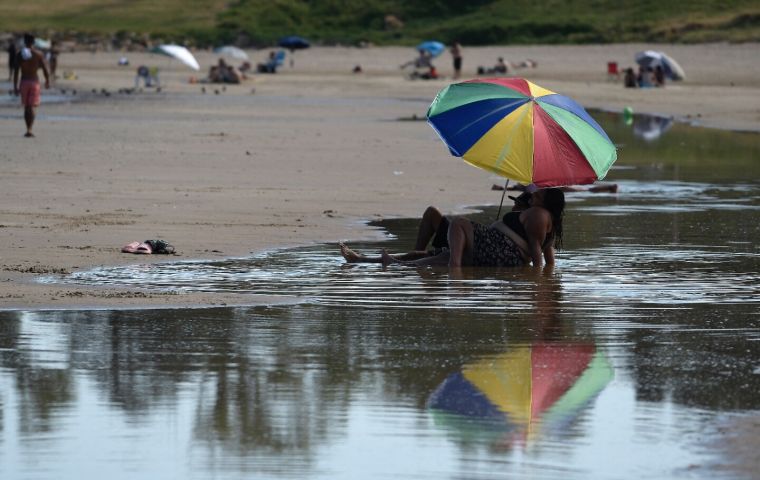MercoPress. South Atlantic News Agency
Heat wave grips Argentina, Chile, Uruguay, Paraguay and Brazil
 The unusually hot weather is expected to stay around at least for a week
The unusually hot weather is expected to stay around at least for a week Media reports all across the Southern Cone Friday underlined the heat wave affecting Argentina, Brazil, Chile, Uruguay, and Paraguay with temperatures reaching 48 degrees Celsius and forecast to remain around or above 40 degrees for several days.
Paraguayan health authorities have asked the population to avoid prolonged exposure to the sun and recommend the use of sunscreen, umbrellas, and light clothing between 10 am and 5 pm to cope with wind chill factors of up to 48ºC. Meteorology and Hydrology Director Eduardo Mingo said very high temperatures were to be expected. “I am talking about 43ºC in the shade of a weather box that is covered by direct solar irradiation,” he explained.
Temperatures nearing 40ºC were also detected in central Chile, coupled with multiple wildfires that have reportedly left at least 10 people dead. On Friday, the Transport Ministry imposed a total traffic shutdown as a result of poor “visibility due to smoke” on Route 68 from Santiago to Valparaiso.
Similar temperatures are also expected for the next few days in the Brazilian State of Rio Grande do Sul (south), according to the meteorological information agency MetSul.
The Uruguayan Institute of Meteorology (Inumet) confirmed that the heat wave would last until Feb. 9 with maximum temperatures of up to 41°C. This heat wave phenomenon is caused by a ”very warm air mass affecting the country, generating high temperatures with high thermal sensations (wind chill),” Inumet Director Néstor Santayana explained. Extreme minimum temperatures between 22 and 25 ºC have also been heralded.
Inumet also announced that on Sunday a cold front would bring a temporary drop in temperatures to the southern and eastern coastal departments (provinces) only to soar again from Monday. “In areas where storms and rains develop, temperatures may temporarily drop slightly,” Inumet said in a statement.
In this scenario, electricity suppliers in the region are facing an increased demand which sometimes they are unable to meet. Hence, power cuts have been reported, particularly in Argentina, where the National Meteorological Service has warned of “extremely high maximum temperatures” in the north, northwest, and center west of the country. The phenomenon is expected to last at least 7 to 9 more days.
Argentine meteorologists have recorded temperatures above 40ºC, with 21 territories out of 24 under alert. Buenos Aires Thursday encored its historical maximum of 38.1ºC from Feb. 12, 2023. The heat wave coincides with the growth stage of crops such as soybean and corn -of which Argentina is one of the world's main producers- and the lack of rain began to affect them, so that “the prospect of a great campaign begins to fade,” according to the Rosario Grain Exchange.
At least 36,000 households in the Buenos Aires Metropolitan Area (AMBA) were reported to have suffered power cuts as physicians urged the population to look after their children and also people over 65. A healthy adult should consume between 2.5 to 3.5 liters of water per day, it was explained.




Top Comments
Disclaimer & comment rules-

Read all commentsIt’s happening again, this is becoming a yearly event, the article below is from a year ago.
Feb 03rd, 2024 - 02:57 pm +1https://www.worldweatherattribution.org/vulnerability-and-high-temperatures-exacerbate-impacts-of-ongoing-drought-in-central-south-america/#:~:text=Drought-,South%20America,lowest%20rainfall%20in%2035%20years.
Maybe now they will stop clearing forest to grow GHG emitting Soya beans, which won’t grow now anyway because of the lack of rainfall.
Or wait until you can walk from Argentina to Uruguay without getting your feet wet.
Commenting for this story is now closed.
If you have a Facebook account, become a fan and comment on our Facebook Page!